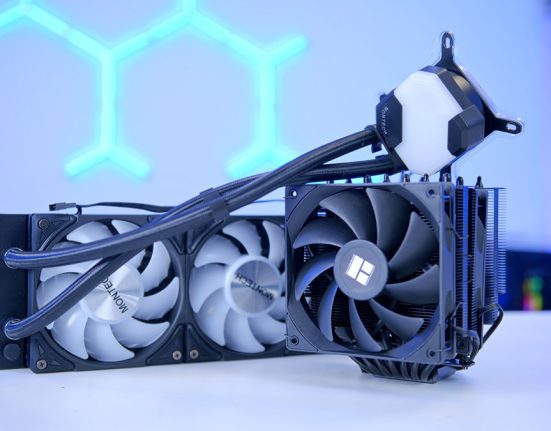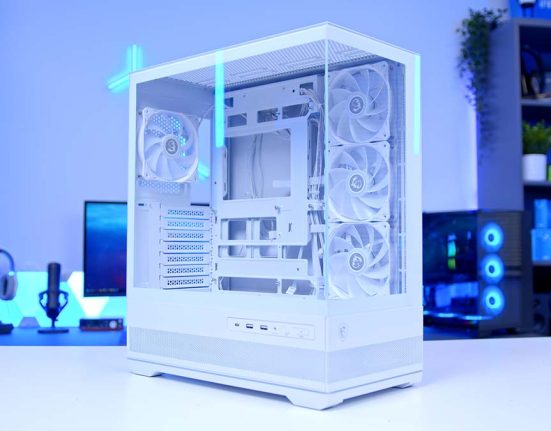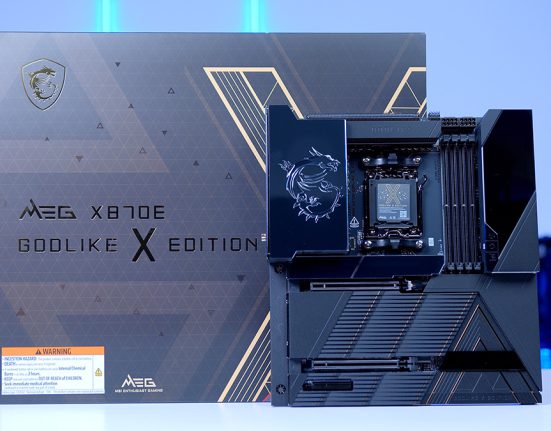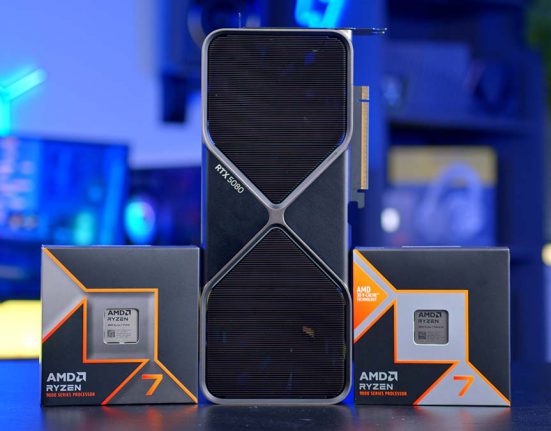The MSI Gaming X Slim variant of the RTX 4070 Ti SUPER is one of the more interesting SKUs compared to some of the alternative model cards. The main reason is its size. As part the name ‘Slim’ suggests, this card is a slimline version that takes up less space inside a PC case. Many RTX 4070 Ti SUPER models are relatively large, so smaller triple fan cards are a welcome addition to the lineup, even if they are a bit pricier. However, with RTX 5000 graphics cards rumoured to be announced during CES, is the RTX 4070 Ti SUPER worth picking up in 2024? We’ve tested this in a set of gaming benchmarks to see how the MSI RTX 4070 Ti SUPER Gaming X Slim holds up.
The NVIDIA RTX 4000 SUPER range was a much-needed refresh to the existing RTX 4000-Series graphics cards range. The RTX 4070 Ti SUPER, in particular, received some hefty upgrades compared to the original RTX 4070 Ti, now with more VRAM, cores, and a more substantial memory bus, significantly increasing its value when comparing its pricing.
In this review of the RTX 4070 Ti SUPER Gaming X Slim, we’ll examine the specs, architecture, design, and performance to determine whether this GPU is a worthwhile purchase in 2024.
Buy the MSI RTX 4070 Ti SUPER Gaming X Slim on:
Specification
Moving onto the specs, the RTX 4070 Ti SUPER has 16GB of GDDR6X VRAM on a 256-bit memory bus. We generally recommend 16GB of VRAM for 4K gaming, primarily as modern titles use more VRAM across the board. This GPU also features a 256-bit memory bus compared to the 192-bit bus on the original RTX 4070 Ti. A stronger memory bus means more bandwidth, allowing the card to process larger amounts of data at a faster rate.
The RTX 4070 Ti SUPER operates at a base frequency of 2.34GHz, which is relatively fast. The RTX 4000 SUPER cards are clocked slightly higher than their predecessors, giving them an edge within games and other applications. The boost clock speed can surge up to 2.68GHz on its boost speed, which is a 0.7GHz rise over the base model, further aiding performance.

Regarding core counts, CUDA, RT and Tensor cores all received an increase compared to the original RTX 4070 Ti. A larger stack of CUDA cores is enticing, as these are primarily responsible for handling the processing power behind DLSS. So, more cores means stronger support for DLSS technology. A similar train of thought can be applied to the RT cores, as these process RTX ray tracing data when this is enabled.
The RTX 4070 Ti SUPER draws 285W from the wall, requiring a 750W power supply at a minimum. However, those with plenty of additional components, such as extra fans, RGB strips, and custom cooling loops, will want to go for an 850W to avoid the potential risk of transient spikes. Clocking in at 307mm long, the RTX 4070 Ti SUPER Gaming X Slim is compact. Most modern cases can accommodate this size and will have additional space at the end for extra fans or a cooler.
| Specification | MSI RTX 4070 Ti SUPER Gaming X Slim |
|---|---|
| Video Memory | 16GB GDDR6X |
| Memory Bus | 256-bit |
| Base Clock Speed | 2.34GHz |
| Boost Clock Speed | 2.68GHz |
| CUDA Cores | 8448 |
| RT Cores | 66 |
| Tensor Cores | 264 |
| Power Draw | 285W |
| Length | 307mm |
Pricing-wise, the MSI Gaming X Slim variant of the RTX 4070 Ti SUPER is around $849.99, which is about $50 more than the base MSRP. But because it has more fans, a slimline design, and a slightly overclocked boost speed, you’re paying a premium for the additional features and design elements. Regardless, I don’t think the RTX 4070 Ti SUPER is exorbitantly priced, especially when you take the hardware improvements that came with the SUPER refresh into account.
Architecture
NVIDIA’s RTX 4000 range of graphics cards uses the Ada Lovelace architecture. This hardware has brought along some significant improvements in its wake, namely changes to DLSS and RTX ray tracing. DLSS, in particular, is one of the more impressive elements of the Lovelace architecture that RTX 4000 resides upon. DLSS is in its third iteration, offering quality and performance improvements. Additionally, NVIDIA provides a branch of DLSS known as Frame Generation, which uses AI to generate frames between frames, improving perceived smoothness.
These technologies are helpful in games or applications where performance isn’t quite at the level you’d like it to be. Switching these on helps bolster framerates where possible. Aside from the new tech, Lovelace brings more efficiency and raw power than the previous generation’s Ampere architecture (RTX 3000).

Furthermore, the arrival of RTX 4000 graphics cards also changed the cabling for graphics cards. Instead of the traditional PCI-E 6+2 pin connectors, which have been used for the past ten years, Lovelace cards over a certain wattage use the 12VHPWR cable by default. This will require a PSU upgrade for those looking to avoid the somewhat controversial PCI-E adapters. But despite the perception of these cables, I believe they’re a welcome addition, allowing you to use one connector instead of multiple. And because they can pipe up to 600W of power, it’s unlikely that you’ll need to use a second.
The major takeaway from the architecture is that NVIDIA has made solid improvements to the efficiency, processing power, and technologies that come with their graphics cards. RTX 4000 SUPER pushes this even further, with the refreshed cards offering more cores or stronger VRAM support for those looking to maximise their framerates at 1440p and 4K.
MSI RTX 4070 Ti SUPER Gaming X Slim Design
MSI’s Gaming X Slim version of the RTX 4070 Ti SUPER features a reasonably simplistic design. Covered in a black shroud with lighter accents on the corners, this card has a somewhat dark aesthetic, blending in with a massive range of components. It features three fans offering solid thermals and airflow. When temperatures are low, the fans on this card switch off entirely, ensuring minimal noise.

The Gaming X Slim’s back features a metal backplate that provides stability for the card. The backplate feels very premium, and the large vent on the rear of the GPU allows air to easily exhaust, aiding temperatures.
In terms of lighting, MSI has taken a relatively minimalist approach. The only area of the card featuring RGB is the top. I think the lighter approach to RGB works for this card, mainly because of the dark design, but those looking to make their build look more fancy can customise the lighting using the MSI Center application.

The other area to touch upon is size. The RTX 4070 Ti SUPER is a pretty big graphics card overall. Most AIB offerings were 2.5-slot and 3-slot GPUs, which raises concerns for those building in small form factor cases. However, the Gaming X Slim variant changes this. The card measures 307mm long and 125mm wide. The width is the critical spec to note, making the Gaming X Slim a 2-slot card rather than one of the bigger options. As mentioned in the specs section, slipping into a small form factor build is considerably easier, provided your case is long enough.
Overall, the MSI RTX 4070 Ti SUPER Gaming X Slim is well-designed. The black aesthetic is simple yet sophisticated and blends well with other similarly themed parts.
Performance
To determine how the MSI RTX 4070 Ti SUPER Gaming X Slim performs, it’s been tested in a series of gaming benchmarks at 1440p and 4K. Our in-house expert, Harry Coleman, conducts all of our testing with a dedicated benchmarking system. He has tested the RTX 4070 Ti SUPER and several other cards and compared them against one another. Check out our How We Test Graphics Cards article for a deep dive into our testing methodologies.
Cyberpunk 2077
Settings: 1440p, Shadow Quality High, Indirect Lighting High, Reflections High, Crowd Density High, Particle Quality High, Volumetric Lighting High, Motion Blur off, GTAO Quality High, Grass Quality High, Contact Shadows High VSync Off, DLSS: On/Off, Ray Tracing: On/Off, Textures: High
In Cyberpunk 2077 at 1440p high settings, we ensured that DLSS 3.0 and ray tracing were off and ran the benchmark. On average, the RTX 4070 Ti SUPER offered 124FPS, which is a strong metric at this resolution. Cyberpunk 2077 is a more visually demanding title, but the RTX 4070 Ti SUPER performed well in rasterised gameplay. This average places it between the RX 7900 XT and the RTX 4080, with a 1FPS difference versus the RX 7900 XT and a 10FPS difference below the RTX 4080.

Starfield
Settings: 1440p/4K, Shadow Quality High, Indirect Lighting High, Reflections High, Crowd Density High, Particle Quality High, Volumetric Lighting High, Motion Blur off, GTAO Quality High, Grass Quality High, Contact Shadows High VSync Off, DLSS/FSR OFF
In Bethsda’s space exploration title – Starfield, the RTX 4070 Ti SUPER performed well at 1440p. Starfield isn’t well optimised, so we’re seeing diminished framerates compared to our Cyberpunk 2077 run, but the RTX 4070 Ti SUPER offered a solid average of 98FPS. The gameplay was smooth across the board, even in more demanding areas like New Atlantis. This places the RTX 4070 Ti SUPER just below the RX 7900 XT, with a 5FPS difference, to be specific. AMD cards generally perform better in this game, but the RTX 4070 Ti SUPER held up well.

Dialling up the resolution to 4K and framerates definitely took a hit. The RTX 4070 Ti SUPER squeezed out a 67FPS average, which is still decent, considering how tough this title can be to run. Switching on DLSS would significantly help here, but it’s great to see that the RTX 4070 Ti SUPER is up to the task when it comes to 4K gameplay.

Apex Legends
Settings: 1440p, Anti-aliasing TSAA, Texture Filtering 8X, Model Detail High, VSync Disabled, Effects High, Ambient Occlusion Quality High
Moving onto an Esports title, Apex Legends, we ran this game at 1440p high settings. As you can see from the graph, most graphics cards tend to perform pretty well at 1440p, which comes down to how well-optimised Apex Legends is. The RTX 4070 Ti SUPER in this game outputs around 256FPS, sitting just below the RTX 4080 at 260FPS and just above the RX 6950 XT at 255FPS. Overall, the gameplay here is strong.

Hogwarts Legacy
Settings: 1440p/4K, Effects High, Material High, Fog High, Sky High, Foliage High, Post Process High, Shadows High, Textures High, View Distance High, Population High, Anti Aliasing TAA High, Windowed Fullscreen.
In Hogwarts Legacy at 1440p high settings, the RTX 4070 Ti SUPER offered an impressive average framerate of 117FPS, placing it, yet again, just below the RTX 4080 at 126FPS and above the RX 7900 XT at 115FPS.

When we bumped up the game resolution to 4K, we did see overall framerates drop, but the game was still very playable. The RTX 4070 Ti SUPER in this title outputs 67FPS on average, sitting just below the RX 7900 GRE and RTX 4080. In this title, many AMD cards tend to perform better at 4K, which is why a slightly weaker card beats out the RTX 4070 Ti SUPER. Overall, gameplay was still very strong.

Fortnite
The last game we tested was Fortnite at 1080p competitive settings, with everything dialled to low apart from the view distance. Obviously, the RTX 4070 Ti SUPER isn’t aimed at 1080p, but it’s great to see how high framerates can go at this resolution. The RTX 4070 Ti SUPER averaged 315FPS, which is incredibly high. This sits just below the RX 7900 XT, and RTX 4080 SUPER, with a four and five FPS difference between the two.

Conclusion
MSI RTX 4070 Ti SUPER Gaming X Slim
Product Name: RTX 4070 Ti SUPER Gaming X Slim
Brand: MSI
-
Features
-
Design
-
Performance
-
Value For Money
Summary
The MSI RTX 4070 Ti SUPER Gaming X Slim is a solid graphics card aimed at 1440p gaming, with decent legs at 4K. This GPU offers a slimline design, making it easy to slip into a small form factor case without any issues, and the triple-fan design ensures temperatures remain cool under load. The biggest win for the RTX 4070 Ti SUPER is its performance across modern games. At 1440p, this card soars, offering reliable framerates, and in 4K, while framerates are lower, it’s generally very playable. With DLSS enabled, performance is enhanced even further, making 4K gaming much more feasible if you’re willing to sacrifice some visual fidelity and latency.
The biggest competitor for the RTX 4070 Ti SUPER is the RX 7900 XT. Priced at $649 when writing, the RX 7900 XT offers similar and sometimes better performance in various games, making it a solid option for those looking to save a bit of cash. However, with DLSS and ray tracing thrown into the mix, the RTX 4070 Ti SUPER stands out compared to the competition, especially if you want to leverage higher framerates or greater visuals. Overall, the MSI RTX 4070 Ti SUPER Gaming X Slim is a solid card for gamers building a high-end compact PC.
Pros
✅ Great 1440p performance
✅ Slimline design
✅ Solid cooling performance
Cons
❌ Similar performance to 7900 XT
❌ Pricier than MSRP
❌ Lower framerates at 4K



![FI_[DP056] Antec flux M + 9060XT](https://geekawhat.com/wp-content/uploads/2025/12/FI_DP056-Antec-flux-M-9060XT-551x431.jpg)




